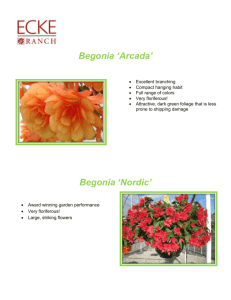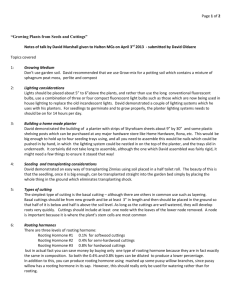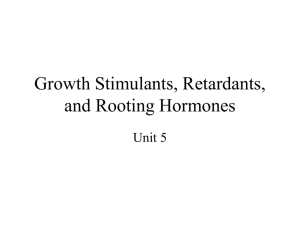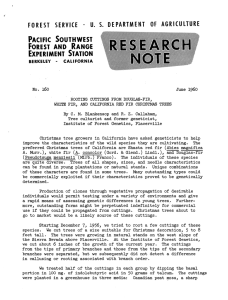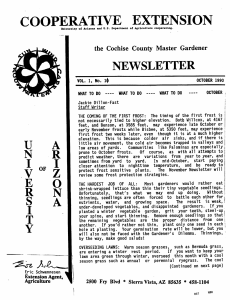Effects of long-term pruning, meristem origin, ... on the rooting of Douglas-fir stem ...
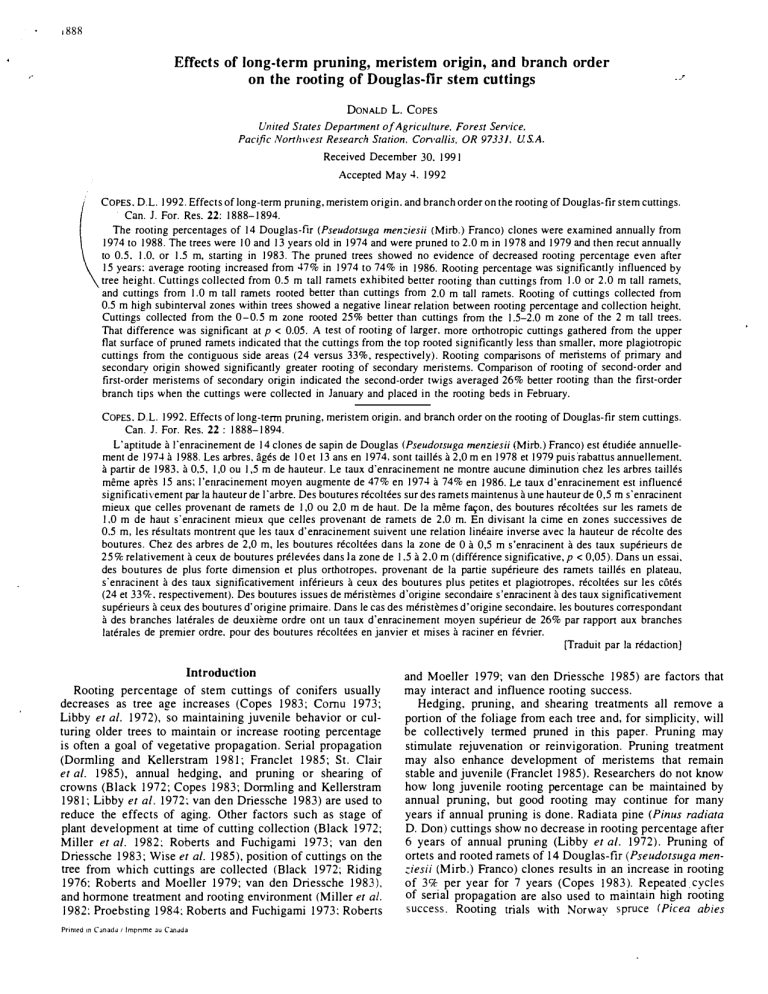
Effects of long-term pruning, meristem origin, and branch order on the rooting of Douglas-fir stem cuttings
DoNALD L. CoPEs
United Stares Depanmenr of Agriculture. Forest Sen,ice,
Pacific Nonlmest Research Station. Con•al/is, OR 97331. U.S.A.
Received December 30. 1991
Accepted May 4. 1992
COPES. D.L. 1992. Effects of long-term pruning, meristem origin. and branch order on the rooting of Douglas-fir stem cuttings.
·
Can. J. For. Res. 22: 1888-1894.
The rooting percentages of 14 Douglas-ftr (Pseudorsuga men::.iesii (Mirb.) Franco) clones were examined annually from
1974 to 1988. The trees were 10 and 13 years old in 1974 and were pruned to 2.0 m in 1978 and 1979 and then recut annuallv to 0.5. 1.0. or 1.5 m, starting in 1983. The pruned trees showed no evidence of decreased rooting percentage even aft
e"
r
15 years: average rooting increased from 47% in 1974 to 74% in 1986. Rooting percentage was significantly influenced by tree height. Cuttings collected from 0.5 m tall ramets exhibited better rooting than cuttings from 1.0 or 2.0 m tall ramets. and cuttings from 1.0 m tall ramets rooted better than cuttings from 2.0 m tall ramets. Rooting of cuttings collected from
0.5 m high subinterval zones within trees showed a negative linear relation between rooting percentage and collection height.
Cuttings collected from the 0 - 0.5 m zone rooted 25% better than cuttings from the 1.5-2.0 m zone of the 2 m tall trees.
That difference was significant at p <
0.05. A test of rooting of larger. more orthotropic cuttings gathered from the upper flat surface of pruned ramets indicated that the cuttings from the top rooted significantly less than smaller, more plagiotropic cuttings from the contiguous side areas (24 versus 33%, respectively). Rooting comparisons of meristems of primary and secondary origin showed significantly greater rooting of secondary meristems. Comparison of rooting of second-order and first-order meristems of secondary origin indicated the second-order twigs averaged 26% better rooting than the first-order branch tips when the cuttings were collected in January and placed in the rooting beds in February.
CoPES. D.L. 1992. Effects of long-term pruning, meristem origin. and branch order on the rooting of Douglas-fir stem cuttings.
Can. J. For. Res. 22: 1888-1894.
L'aptitude a I'enracinement de 14 clones de sapin de Douglas (Pseudorsuga menziesii (Mirb.) Franco) est etudiee annuelle ment de 1974 a 1988. Les arbres. ages de 10 et 13 ans en 1974, sont tailles a 2,0 m en 1978 et 1979 puis ·rabattus annuellement. a partir de 1983. a 0,5, 1,0 ou 1,5 m de hauteur. Le taux d'enracinement ne montre aucune diminution chez les arbres tailles meme apres 15 ans; l'ertracinement moyen augmente de 47% en 1974 a 74% en !986. Le taux d'enracinement est influence significativement par Ia hauteur de l'arbre. Des boutures recoltees sur des ramets maintenus a une hauteur de 0,5 m s' enracinent mieux que celles provenant de ramets de 1,0 ou 2,0 m de haut. De Ia meme f�t9on, des boutures recoltees sur les ramets de
I ,0 m de haut s
· ertracinent mieux que celles provenant de ramets de 2.0 m. En divisant Ia cime en zones successives de
0.5 m, les resultats montrent que les taux d'enracinement suivent une relation lineaire inverse avec Ia hauteur de recolte des boutures. Chez des arbres de 2,0 m, les boutures recoltees dans Ia zone de 0 a 0,5 m s'ertracinent a des taux superieurs de
25% relativement a ceux de boutures prelevees dans Ia zone de 1.5 a 2.0 m (difference significative, p
<
0,05). Dans un essai. des boutures de plus forte dimension et plus orthotropes. provenant de Ia partie superieure des ramets tailles en plateau, s'enracinent a des taux significativement inferieurs a ceux des boutures plus petites et plagiotropes, recoltees sur les cotes
(24 et 33o/c. respectivement). Des boutures issues de meristemes d'origine secondaire s'enracinent a des taux significativement superieurs a ceux des boutures d' origine primaire. Dans le cas des meristemes d' origine secondaire. les boutures correspondant a des branches laterales de deuxieme ordre ont un taux d'ertracinement moyen superieur de 26% par rapport aux branches
Iaterales de premier ordre. pour des boutures recoltees en janvier et mises a raciner en fevrier.
[Traduit par Ia redaction]
Introduction
Rooting percentage of stem cuttings of conifers usually decreases as tree age increases (Copes
1983; Cornu 1973;
Libby et a!. 1972), so maintaining juvenile behavior or cul turing older trees to maintain or increase rooting percentage is often a goal of vegetative propagation. Serial propagation
(Dormling and Kellerstram 1981; Franclet 1985; St. Clair et al. 1985), annual hedging, and pruning or shearing of crowns (Black 1972; Copes 1983; Dormling and Kellerstram
1981; Libby eta!. 1972; van den Driessche
1983) are used to reduce the effects of aging. Other factors such as stage of plant development at time of cutting collection (Black
1972;
Miller eta/. 1982: Roberts and Fuchigami 1973; van den
Driessche
1983;
Wise et al. 1985), position of cuttings on the tree from which cuttings are collected (Black
1972;
Riding
1976:
Roberts and Moeller
1979; van den Driessche
1983 )
, and hormone treatment and rooting environment (Miller eta/.
1982:
Proebsting
1984:
Roberts and Fuchigami
1973:
Roberts
Primed m
Canada/ lmpnme au
C.111Jda and Moeller 1979; van den Driessche 1985) are factors that may interact and influence rooting success.
Hedging, pruning, and shearing treatments all remove a portion of the foliage from each tree and, for simplicity, will be collectively termed pruned in this paper. Pruning may stimulate rejuvenation or reinvigoration. Pruning treatment may also enhance development of meristems that remain stable and juvenile (Franclet
1985). Researchers do not know how long juvenile rooting percentage can be maintained by annual pruning, but good rooting may continue for many years if annual pruning is done. Radiata pine
(Pinu s radiata
D. Don) cuttings show no decrease in rooting percentage after
6 years of annual pruning (Libby eta/. 1972).
Pruning of ortets and rooted ramets of
14
Douglas-fir (Pseudotsuga men
::iesii (Mirb.) Franco) clones results in an increase in rooting of 3'7c per year for 7 years (Copes
!983 ) .
Repeated. cycles of serial propagation are also used to maintain high rooting success. Rooting trials with Norway spruce (Picea abies
·
JK.arst.) show stable rooting success through a 13-year period in which five 3-year serial propagation cycles were made
(St. Clair et
al.
1985).
Variable rooting occurs with cuttings of different branch orders. Pruning also influences the production of twigs of different branch orders. Investigation of the effect of branch order on rooting percentage is difficult because of complex interactions with date of cutting collection (Black 1972;
Roberts and Fuchigami 1973), hormone treatment (Cornu
1973; Roberts and Fuchigami 1973), and tree age (Black
1972). As a result, some studies comparing rooting percentage among cuttings of different branch orders report no difference in rooting percentage (Brix 1974; Hinesley and Blazich 1984), whereas other studies (some done with the same species) report significant differences (Black 1972; Cornu 1973;
Miller et
al.
1982; Roberts and Fuchigami 1973).
In the following study, a number of separate rooting inves tigations were conducted. The primary rooting tests were made from I 982 to 1988 and investigated the annual rooting performance of ortets and ramets of the same 14 Douglas-fir clones that were pruned each January from 1978 to 1988. The ability of pruning to maintain or increase rooting was exam ined, as was the effect of tree height and position of cuttings on the trees (height above the ground). Other trials were conducted to test differences in rooting percentage between cuttings collected from the very top of the trees versus cuttings collected from the sides of the trees, between primary versus secondary meristems, and between first- and second-order secondary meristems. The study results will be useful to vegetative propagators, geneticists, and tree improvement workers who wish to maintain or increase rooting percentage of Douglas-fir and will provide additional insight into how pruning achieves that goal with Douglas-fir.
Methods
The primary test of continued-pruning effect on rooting percentage encompassed the period 1 982-1 988. Cuttings were gathered each year from rooted ramets of the same 1 4 Douglas-fir clones. Rooting pro cedures and percentages of the same ramets and ortets from 1 97 4 to
1 981 were previously reported (Copes 1 983). The source trees were either 1 8 or 21 years old from seed in 1 982. The 21 2 rarnets of the
1 4 clones had been selected and rooted in 1 972 and 1 973 and field planted in 1 975 and 1 976, respectively (Copes 1 981 ). Pruning trees to 2-m height was initiated in 1 978 and 1 979 when the ramets exceeded that height limit. In most cases, only shoots from the past growing season were cut, but some cutting back into older branch wood was needed during the first 3 years of pruning to smooth the irregular surface of the tree for future prunings. In 1 983, equal numbers of the 2.0 rn tall ramets of each clone were pruned to heights of 0.5, 1 .0, and 2.0 rn. The foliage from the top and side of each tree was pruned annually through 1 988. In 1 988, twigs were collected for rooting from 0.5 rn wide subinterval zones. The subinterval zones were the areas between horizontal planes dividing the vertical dimen sion of each tree into 0.5 m wide areas starting at the ground. In 1 990, a secondary test was made comparing the rooting percentage of cut tings collected from the top or sides (within 25 ern of the top surface) of each pruned rarnet. Another secondary test of rooting percentage resulting from differences in meristern origin and branch order was made in 1 987 with 5 trees that were 1 5 years old and 84 trees that were 7 years old. The trees had never been pruned previously and all
7-year-old trees selected had two terminal leaders.
Propagation procedures were identical with those used for the same clones from 1 974 to 1 981 (Copes 1 983). In brief, the cuttings, con sisting entirely of growth from the past year, were collected in January and stored in plastic bags at I to 2°C until early February; the basal
COPES
1 889
3 em was soaked for 5 s in 5000 ppm indole-3-butyric acid; they w re pricked into sphagnum peat moss and fine sand (2:1 v/v) in clonal rows of 1 3 or 14 cuttings in outdoor rooting houses, subjected to intermittent mist during daylight hours, and grown in a medium maintained by electric soil cables at about 21 °C and sprayed weekly with 20:20:20 (N-PzOs-KzO) fertilizer and fungicide. The 1 987 sec ondary rooting trial of meristem origin and branch order in 9-year-old trees was done as just described, except that the cuttings were grown in planting flats (56 x 30 x 9 em) in a fog chamber in a conventional greenhouse. Cuttings grown in the fog chamber were also watered as needed. Cuttings were grown under a natural photoperiod in the misting beds and fog chamber until October or November. At that time, the cuttings were lifted and rooting success was recorded as the number of cuttings that had initiated roots in each clonal row of 1 3 or
1 4 cuttings.
Experimental designs of studies from 1 982 through 1 990 are listed in Table I. Rooting trials were subjected to analysis of variance
(ANOVA) using the SAS procedures for general linear models. The number of cuttings that rooted per clonal row of 13 or 1 4 cuttings was the experimental unit for all analyses, except in the first ANOV A analysis in Table 3. In that analysis the experimental unit was year x clone means. Percentage data were converted to angular values before AN OVA. Significance was achieved when p < 0.05. Clones were considered random effects because the trees had not been selected for rooting percentage. Additional details on design of individual tests can be determined from the ANOV A tables for each test.
Results
Clonal and yearly rooting percentages from
I
974 to
I
988 are shown in Table 2 for each of the 14 Douglas-fir clones.
Rooting results from I 974 to I 981 were previously published for the_same 14 clones (Copes 1983) and are included to facilitate the comparison of rooting over the entire 15 years.
Data for 1978 and 1983 are omitted because extensive disease losses in the propagation beds prohibited gathering mean ingful data on rooting percentage. In addition, the rooting percentage values for 1984 and 1987 are somewhat reduced because of moderate disease losses. Average yearly rooting from 1974 to 1988 increased from 45% in 1976 to 74% in
198f). Clones that rooted the poorest in 197 4 generally expe rienced the greatest gains over the 15-year study. Plant age dur ing that interval increased from 10 and 13 to 24 and 27 years old, respectively.
Both the year and clone effects were highly significant
(p
<
0.05) (Table 3). Average rooting percentage of each clone and individual year values for 1974 and 1988 are ranked clonally
(Table 2) in order of highest to lowest rooting clones. In general, clones with the highest or lowest rooting percentage in I 97 4 remained the better or poorer rooting clones, respec tively, 15 years later but exceptions did occur.
Rooting trials from 1984 to 1988 tested the rooting per centage of cuttings collected fr()J11 ramets pruned to 0.5, 1.0, and 2.0 m. Cuttings gathered froin the shorter trees exhibited greater rooting percentage than did cuttings collected from taller trees in 9 of the 10 height-year comparisons (Fig. 1 ).
The one exception occurred in 1987, when cuttings collected from the 1.0 m tall trees rooted slightly better than the cuttings from the 0.5 m tall trees. Year, clone, and tree height main effects were all highly significant
(p
< 0.05) (Table 3). The main effect for tree height was predominantly a negative linear relation. Significant interactions were noted for year x clone and the quadratic component of clone x tree height
(Table 3 ). The clone x tree height interaction had a significant nonlinear response primarily because of the rooting response
'
11\ U
CAN. J. FOR. RES. VOL. 22. 1992
(A) Primary tests
TABLE I. Experimental designs of primary and secondary rooting tests
Year
Aging and pruning
1 982
1 984
1 985
1 986
1 987
1 988
(B) Secondary tests
No. of clones
1 4
1 4
1 4
1 4
1 4
1 4
Tree ht.
(m)
2.0
0.5, 1 .0, 2.0
0.5, 1 .0, 2.0
0.5, 1 .0, 2.0
0.5, 1 .0, 2.0
0.5, 1 .0, 2.0*
No. of replications in rooting bed
3
3
2
7
4
I
No. of rows per replication
6
I
2
I
I
I
No. of cuttings per row
1 4
1 4
1 4
1 4
1 4
1 3
Year
No. of clones
Tree height (m) or cutting typet r No. of replications in rooting bed
No. of rows per replication
No. of cuttings per rowt
Cuttings from top and side of tree:j: 1 990 1 4 0.5 1 .0 2.0 3
TS FO
1 3 so
Meristem origin and branch order
1 987
1 987
84
5
TS, FO, SO
FO, SO
2
4
2
1 4
2
14
*Subinterval zone collections of cuttings from the 1.0 and 2.0 m tall trees were collected from areas 0-0.5, 0.5-1.0, 1.0-1.5, and 1.5-2.0 m above the ground. tMeristem origin and branch order were noted by the following: terminal shoot, TS; flrst-order lateral, FO; second-order lateral, SO.
+Cuttings from both the tops and sides of trees were collected from all three tree heights and kept separate by collection location on tree.
.-
'
TABLE 2. Clonal and annual rooting percentage from 1 97 4 to 1 988, with 1 4 clones ranked from highest to lowest means
Year
Clone* 74 75 76 77 79 80 81 82 84 85 86 87 88 Meant
j
k
I m n e f g h a b c d
23
1 7
41
36
57
33
1 6
83
78
80
41
51
66
40
88
49
59
61
73
58
49
37
45
1 8
27
60
32
1 6
.
72
74
-+
37
27
1 5
49
77
58
38
38
49
32
23
66
68
55
67
65
37
59
76
58
76
71
61
62
64
74
66
67
62
42
74
49
62
36
66
66
25
41
31
68
65
-+
58
62
65
32
71
52
65
68
64
56
46
65
62
84
78
68
82
75
70
83
76
57
62
49
71
65
70
63
56
36
34
82
62
8i
74
73
77
67
82
67
61
37
38
80
58
88
92
67
82
56
70
67
64
62
76
32
55
47
48
55
33
70
56
39
1 0
54
37
47
53
52
70
44
75
74
67
63
72
55
37
40
55
87
63
81
65
54
66
68
91
89
84
73
69
80
70
73
68
69
71
81
96
68
87
63
46
54
52
45
38
78
69
66
64
50
46
46
42
63
63
62
60
58
57
Mean 47 48 45 54 63 59 66 70 48 66 74.-
-·
57 65 59
*Clones in a previous study (Copes 1983) were coded as follows: a, 109; b, 23; c, 25; d. 197; e, 3; f,
102; g, 172; h. 241; i. 106; j.
4; k, 20:
I,
14; m. 97: n, 223. tSome values are dissimilar to those reported in Copes (1983) because a different weighting procedure was used when averaging clonal means.
+Data missing because the clone was not collected for rooting. of clones with intermediate rooting percentages (Fig. 2). The clones with the poorest and best rooting percentages were more consistent in rooting response.
Different rooting percentages were found among cuttings collected at different heights within trees. Cuttings collected from branches growing closest to the ground had the greatest rooting percentage (Table 4). A significant negative linear relation between rooting percentage and collection height was detected among cuttings gathered from the four 0.5 m wide subintervals of the 2.0 m tall trees, but not among the two
0.5 m wide subinterval zones of the 1.0 m tall trees (Table 5).
Comparison of rooting percentage of cuttings from the 0-0.5
J
UJ 70
UJ u a:
60
50
8
40 a:
30
20
100,----------------------------,
90
80
COPES 1891
TABLE 4.
Effect of tree height and subinterval collection zones oh
1988 rooting percentage
Rooting % of subinterval zone
Tree ht.
(m)
No. of cuttings 0-0.5 0.5-1.0 1.0-1.5 1.5-2.0 Mean
0.5
1.0
2.0
Mean
728
1456
2912
75
77
78
77
69
74
72
70
70
53
53
7
75
-
3
69
71
NoTE: Subinterval zones denote the 0.5 m wide sample-collection zones formed between horizontal planes cutting sample areas across the vertical dimension of the plant at the specified distances above ground.
10
1984 1985 1986 1987
YEAR OF ROOTING
1988
FIG. I. The effect of tree height (0.5, 1.0, or 2.0 m) on rooting percentage from 1984 through 1988.
TABLE 3. ANOV A tables for rooting percentages of 14 clones for the period 1974-1978 for all tree )1eights and 1984-1988 for clones pruned to 0.5, 1.0, and 2.0 m heights
Source df ss F
1974-1988 for all heights
Year
Linear
Nonlinear
Clone
Year x clone (error)
Total
12
I
I I
13
154
179*
1.756
0.713
1.043
1.991
2.952
6.699
7.63
37.22
54:41
7.99
1984-1988 for 0.5, 1.0, and 2.0 m tall trees
Year
Linear
Nonlinear
Replications/year
(error
I)
Clone
Year x clone (error 2)
Tree ht.t
Linear
Quadratic
Year x tree ht.
Clone x tree ht.
Linear
Quadratic
Year x clone x tree ht.
(error 3)
Experimental error
Total
4
1
3
8
13
52
26
13
13
104
482
699
2
I
I
8
7.784
2.154
5.629
1.705
13.651
7.736
1.644
1.644
0.000
0.318
2.021
0.531
1.490
5.895
22.878
63.632
9.13
10.11
8.81
7.06
3.13
13.53
27.06
0.00
0.70
1.37
0.72
2.02
1.19
*Clone i data are missing in 1976 and 1980. tSattenhwaite approximation was used. p >F
0.000
0.000
0.000
0.000
0.004
0.013
0.006
0.000
0.000
0.003
0.001
0.999
0.690
0.134
0.739
0.026
0.117 subinterval zones of the 0.5 and 1.0 m tall trees and the
0-0.5 and 0.5-1.0 subinterval zones of the 1.0 and 2.0 m tall trees indicated slightly less rooting percentage when the sub-
T ABLE 5. ANOVA table for !988 rooting percentage of subinterval (0.5 m high) zones within the 1.0 and 2.0 m tall trees
Source df ss F p >F
Replication
Clone
Tree ht.
Linear
Quadratic
Clone x tree ht. (error 1)
Sl*
S I x clone (error 2)
S 2 t
S 2 x clone (error 3)
Experimental error
Total
*Subintervals within 2 m tall trees. tSubintervals within I m tall trees.
I
13
2
1
I
26
3
39
1
13
0.388 14.29 0.0003
7.693 21.82 0.0001
0.545
0.495
3.50 0.0450
6.35 0.0182
0.65 0.4283 0.050
2.024 2.87 0.0000
2.594 11.63 0.0000
2.900
0.184
0.881
97 2.631
195 19.842
2.74 0.0000
2.72 0.1228
2.50 0.0054 interval zones included a proportion of cuttings from the very top of each tree. Those differences were not significantly dif ferent at
p
< 0.05.
Ip 1990, cuttings were gathered solely from the very top of trees pruned at 0.5, 1.0, and 2.0 m or from the side areas immediately below the flat upper surface of each pruned tree.
The overall average rooting success was 33 and 24% for cut tings from the side and top of the trees, respectively, among the three tree heights (Table
6).
The difference in rooting percentage of cutting from the two areas was significantly different
(p
< 0.05) (Table 7). For all tree heights, cuttings gathered from the side of the trees rooted consistently better than cuttings collected from the top of the trees, even though relatively little difference in height differentiated sample zones. Significant interactions of clone x type of cutting, type of cutting x tree height, and c_lone x type of cutting x tree height were found
(p
<
0.05).
··
Cuttings collected that originated from primary meristems exhibited a different rooting percentage than did cuttings orig inating from secondary meristems (Table 8). The same was true of rooting percentage of cuttings from first-order and second-order branch tips of secondary meristems. Nine-year old Douglas-fir trees increased rooting percentage in the fol lowing order: primary meristem (tree terminal), 21 %; first order secondary meristems (tips of main whorl branches),
49%; second-order secondary meristems (branches in whorl at the base of each first-order lateral meristem), 71%. The root ing percentage of first- and second-order lateral meristems of
CAN. J. FOR. RES. VOL.
22. 1992
. /
'
1892
90
80 w
(!) ffi
70
8
60
50
40
30
FIG. 2. A two-dimensional plot of clone-by-tree-height interactions. Clones are distributed on the long diagonal and tree heights on the short diagonal. Arrow lengths indicate the amount of positive or negative deviation from the expected values. Only interactions greater than 0.05 are shown.
TABLE 6. The 1990 rooting percentage of cuttings collected solely from the tops or sides of 0.5, 1.0, and
2.0 m tall trees
Tree ht. No. of
(m) cuttings
0.5
1.0
2.0
Mean
1092
1092
1092
Rooting % by location of cuttings on tree
Top
30
24
17
24
Side
36
38
25
33
Mean
33
31
21
28
15-year-old trees exhibited the same trend (Table 8). Rooting percentages for trees of both ages were significant for cutting type
(p
< 0.05) (Table 7).
Discussion
Results indicated that annual pruning techniques can be used to increase and maintain juvenile-like rooting potential for at least 15 years. Pruning was more successful with older trees than reported previously (Copes 1983). Rooting per centage increased by 27% during the 15 years in which tree age increased from 10 and 12 to 25 and 27 years, respec tively. The average annual gain in rooting potential between ages 18 and 27 years was less than the 3% per year reported for the same clones between ages 10 and 20 years (Copes
1983 ). The long-term trend indicated that most gain in rooting percentage was obtained during the first 4 years of pruning.
Continued annual pruning appeared to maintain the elevated rooting percentage, although unexpected disease losses in the
·. rooting beds prior to root formation occasionally reduced rooting values below what would have occurred without the disease losses. Eliminating such environmental variation is virtually impossible when the tests span many growing seasons. Additional evidence of juvenility or invigoration of pruned ramets was their continued production of abundant lammas shoots each year. Lammas growth ceased on unpruned trees of the same clones when the trees were 10 to
12 years old (Copes 1983).
Most clones maintained approximate rank order during the
15-year study period, but large shifts by individual clones in rank order occurred some years. Roberts and Moeller
(1979) observed similar unexpected changes in rank order among years. Clones that had low rooting percentage at the start of this study exhibited the greatest gains from pruning treatments.
Applied rooting programs will achieve higher rooting success with Douglas-fir if the pruned trees are kept at a low height or if the collection of cuttings is limited to lower crown areas of tall trees. Many -conifers exhibit a lower rooting percentage when cuttings are rooted from branch tips that originated in the upper crown versus branches that originate in crown areas close to the ground (Riding 1976; Roberts and
Moeller 1979; van den Driessche 1983). That same negative linear relationship between collection height and rooting per centage was detected in this study even though the pruned trees ranged in height from only 0.5 to 2.0 m. Rooting per centage of cuttings collected from the 2.0 m tall trees aver aged 6% less than that of cuttings collected from the 0.5 m tall trees. Comparison of rooting percentage of subintervals collected at different heights within the pruned trees also demonstrated the same negative linear relation. Rooting
J -'TABLE 7. ANOVA tables for secondary experiments comparing rooting percentage of the following: cuttings from top and sides of the 1 4 pruned clones. cuttings from primary and secondary meristems and first- and second-order branches of 9-year-old trees, and cuttings from firstand second-order branches of
1 5-year-old trees
COPES
1 893
TABLE 8. Effect of meristem origin and branch order on 1987 roo percentage
ii
' ng
Rooting % by
Source df ss F p>F
Age
Seco n da ry meristem by
No. of Primary
(years) cuttings meristem I st branch order 2nd branch order
9
1 5
840
560
24
*
53
9
77
39
•No multiple tenninals were available for rooting from 15-year-old trees.
Top versus side
Replication
Clone
Replication x clone
(error
I)
Cutting type
Tree ht.
Clone x cutting
Clone x tree ht.
Cutting x tree ht.
Clone x cutting x tree ht.
Experimental error
Total
2
1 3
2
26
1 40
251
26
1
2
1 3
26
0.225
8.857
2.8 1
1 7.01
0.079
0.000
1 .042
0.8 1 5 23.88 0.000
1 .039 1 5.23 0.000
0.734 1 .65 0.077
3.046 3.44 0.000
0. 1 24
2.072
1 .8 1 0. 1 67
2.34 0.00 1
4.775
22.729
Meristem and branch order effects in 9-year-old trees
Flat
Branch type
Flat x branch type
Experimental error
Total
1 3
2
26
42
83
3. 1 53
6. 1 65
1 .035
3.450
1 3.803
2.95
37.53
0.48
0.000
0.000
0.973
Branch order effects in 15-year-old trees
Replication
Clone
Replication x clone
(error
I)
Branch type
Clone x branch type
Experimental error
Total
I
0.0 1 0 0.83
4 0.077 1 .55
4
I
4
5
1 9
0.050
0.680
0.2 1 4
0.062
1 .093
54.67
4.29
0.4 1 5
0.341
0.00 1
0.071 percentage of the 0-0.5 m zone of 1.0 m tall trees was 8% greater than that of the 0.5-1.0 m zone of the same trees. Even greater differences were detected within the 2.0 m tall trees; a 25% difference in rooting percentage existed between the
0-0.5 and the 1.5-2.0 m zones.
One undesirable aspect of advocating collection of Douglas fir cuttings from the lower crown of pruned trees is that those cuttings are usually smaller than cuttings of the same branch orders that grow higher or on the very top surface of pruned trees. The growth habit of Douglas-fir cuttings grown from second-order branch tips may be inferior to first-order branch tips of secondary meristem origin, as is true of Fraser fir
(Abies fraseri
(Pursh) Poir.) cuttings (Miller
eta/.
1982).
Propagators often favor collecting branch tips, for cuttings, that are large and have good potential for upright (orthotropic) growth habit rather than less vigorous, subordinate lateral branch tips. Collection of orthotropic shoots from the flat, upper surface of trees is preferred with radiata pine (Libby
eta/.
1972). In general, larger shoots are desired because the assumption is held that they grow into larger, higher quality plants (Miller
et a/.
1982 ). The flat upper surface that devel oped at the top of Douglas-fir trees that have been annually pruned for at least 3 years produced shoots that are often larger and more orthotropic. Comparison of rooting percent ages in cuttings collected from the 0.5 m high subinterval zones of 1.0 and 2.0 m tall trees indicated less rooting when cuttings were collected from crown areas that included the very top surface of the trees. Other tests of cuttings collected entirely from the top of trees versus cuttings collected entirely from the adjacent side of the trees indicate that cuttings col lected from the side areas rooted an average of 9% better than cuttings from the top. Orthotropic cuttings from the tops of
14-year-old Fraser fire trees also rooted poorer than plagio tropic cuttings from secondary axes of intact plants (Wise
et a/.
1986 ).
Knowledge of the rooting properties of shoots from dif ferent meristem origins and branch orders facilitates under standing how pruning influences rooting percentage. Results of previous studies on branch-order influences on rooting percentage in Douglas-fir are quite contradictory. Black
(1972) found that first-order cuttings rooted better than second-order cuttings if the cuttings were collected in the fall before the bud-dormancy chilling requirements were satisfied, but that second-order shoots root better than first-order branch tips if cuttings are collected during the winter. Roberts and
Fuchigami ( 1973) also found better rooting of lateral branches that occurred with branch terminals when the cuttings were collected in February. They reported that first-order twigs from secondary meristems exhibit greater rooting percentage than do second-order twigs when collected from November to January. The present study generally supported those obser vations and indicated that considerable gains in rooting per centage can be made with January collections and February rooting of second-order lateral meristems. The rooting per centage of primary meristems of trees that had never been pruned was 28 and 50% less than first- or second-order lateral branches of the same trees. Second-order twigs of secondary meristem origin of 9- and 15-year-old trees rooted 22 and
30% better, respectively, than the larger, more dominant first order lateral branch tips.
Studies in which large numbers of cuttings are collected annually from the same trees, in effect, subject the trees to yearly pruning. Such treatment c nges the proportion of buds of different meristem orders that grow into twigs the fol lowing year and may be the reason Roberts and Moeller
(1979) did not report a decline in rooting percentage when rooting the same Douglas-fir trees for 5 consecutive years.
A study with Sitka spruce indicates that pruning changes the type of cuttings produced from first-order and second order to predominantly third-order secondary meristems
(van den Driessche 1985).
Annual pruning increased and then maintained the elevated rooting percentage of 10- and 13-year-old Douglas-fir over a 15-year period. Pruning Douglas-fir appears to be effec tive because it decreases the proportion of first-order twig
1894 CAN. J. FOR. RES. VOL. 22, 1992 of secondary meristem ongm and increases the proportion of secondary and higher order twigs of secondary origin. It requires at least 3 or 4 years of annual pruning to transform the crown areas to a condition that produces primarily higher branch order twigs.
Black, D.K. 1972. The influence of shoot origin on the rooting of
Douglas-fir stem cuttings. Comb. Proc. Int. Plant Propag. Soc. 22:
142-157.
Brix, H. 1974. Rooting cuttings from manore Douglas-fir. N.Z. J. For.
Sci. 4(2): 133-139.
Copes, D.L. 1981. Selection and propagation of highly graft-compat ible Douglas-fir rootstock-a case history. USDA For. Serv. Res.
Note PNW-376.
Copes, D.L. 1983. Effect of annual crown pruning and serial propa gation on rooting of stem cuttings from Douglas-fir. Can. J. For.
Res. 13: 419- 424.
Cornu, D. 1973. Essais pn!Iiminaieres sur Ia selection de clones bou turables de Douglas (Pseudotsuga menziesii Franco). Ann. Sci. For.
30(2): 157-173.
Dormling, I., and Kellerstram, H. 1981. Rooting and rejuvenation in propagating Norway spruce cuttings. In Symposium on Clonal
Forestry, Swedish University of Agricultural Sciences, Uppsala.
Res. Notes 32. pp. 65-72.
Franclet, A. 1985. Rejuvenation: theory and practical experiences in clonal silviculture. In Proceedings of the 19th Canadian Tree
Improvement Association, 22-26 Aug. 1983, Toronto, Ont. Edited by L. Zsuffa, R.M. Rauter, and C.W. Yeatman. Canadian Forestry
Service, Ottawa. pp. 96-134.
Hinesley, L.E., and Blazich, F.A. 1984. Rooting Fraser fir stem cut tings. J. Environ. Hortic. 2(1): 23-26.
Libb
y
, W.J., Brown, A.G., and Fielding, J.M. 1972. Effects of heJging radiata pine on production, rooting, and early growth of cu;tings.
N.Z. J. For. Sci. 2(2): 263-283.
Miller, N.F., Hinesley, L.E., and Blazich, F.A. 1982. Propagation of
Fraser fir by stem cuttings: effects of type of cutting, and genotype.
HortScience, 17(5): 827-829.
Proebsting, W .M. 1984. Rooting of Douglas-fir stem cuttings: relative activity of BA and NAA. HortScience, 19(6): 854 -856.
Riding, R. 1976. The shoot apex of trees of Pinus mariana of different rooting percentage. Can. J. Bot. 54: 2672-2678.
Roberts, A.N., and Fuchigami, L.H. 1973. Seasonal changes in auxin effect on rooting of Douglas-fir stem cuttings as related to bud activity. Physiol. Plant. 28: 215-221.
Roberts, A.N., and Moeller, F.W. 1979. Phasic development and physiological conditioning in the rooting of Douglas-fir shoots.
Comb. Proc. Int. Plant Propag. Soc. 28: 32-39.
St. Clair, J.B., Kleinschmit, J., and Svolba, J. 1985. Juvenility and serial vegetative propagation of Norway spruce clones (Picea abies
Karst). Silvae Genet. 34(1): 42- 48. van den Driessche, R. 1983. Rooting Sitka spruce cuttings from hedges, and after chilling. Plant Soil, 71( 1/3): 495- 499. van den Driessche, R. 1985. The influence of cutting treatments with indole-3-butyric acid and boron, stock plant moisture stress, and shading on rooting in Sitka spruce. Can. J. For. Res. 15: 740 -742.
Wise, F.C., Blazich, F.A., and Hinesley, L.E. 1985. Propagation of
Abies fraseri by semidormant hardwood stem cuttings. HortSci ence, 20(6): 1065-1067.
Wise, F.C., Blazich, F.A., and Hinesley, L.E. 1986. Propagation of
Abiesfraseri by cuttings: orthotropic shoot production from hedged stock plants. Can. J. For. Res. 16: 226-231.
.
.•

